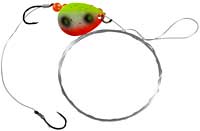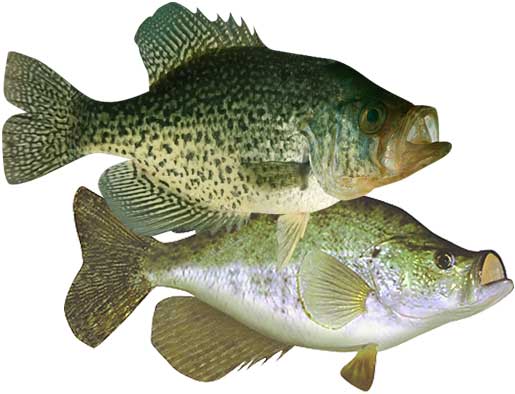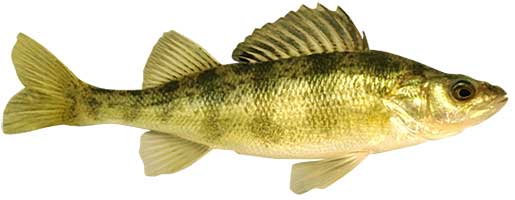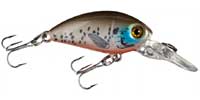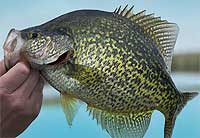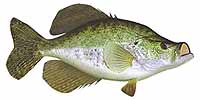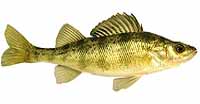Fishing Report For Glendo Reservoir, WY
By Rick Seaman
Last updated on .
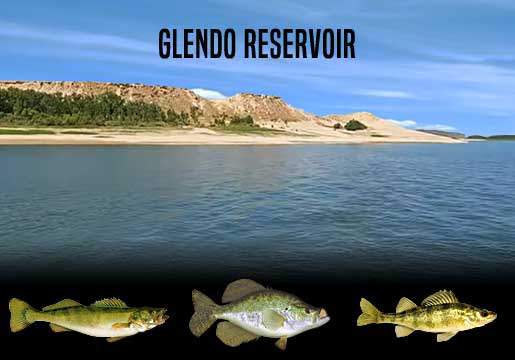
Fishing Reports
Popular Fish Species Glendo Reservoir, WY
Walleye
Current Report: Fair
FALL. Fall brings cooler temperatures to shallow water, drawing walleye and baitfish shallower. The Wyoming Game & Fish Department reports "Glendo Reservoir offers excellent Fall walleye fishing". Walleye continue to be a major draw for anglers. Locals report catching nice walleye on long points, flats along the river and creek channels, and structure off shore. Jigs, swimbaits, spoons, crankbaits, jerkbaits, and spinnerbaits are all historically good for catching walleye this time of year. Early Fall finds them in 10 to 25 feet of water. Later in Fall, they move out slightly deeper. Dragging jigs, bottom bouncers, or worm harnesses with nightcrawlers or leeches, around ledge drop-offs is catching walleye fairly consistently. Watch for the bigger walleye to be slightly deeper than the majority of the school.
WINTER. Ice fishing for walleye at Glendo Reservoir is good for several months each year. Before, during and after the ice, anglers report catching them in 20 to 35 or 40 feet of water, along creek channel edges, rocky humps and ledges. They primarily feed on small fish, staying close to the bottom. After ice-out blade baits, jigs, swimbaits, spoons, deep-diving crankbaits, and worm harness spinners, all work while deep trolling or drifting.
SPRING. Early Spring brings warming water in the shallows, and draws walleye here to feed, especially rocky areas and inlet channels. In Spring work deep points, drop offs, submerged structure, rock ledges, deeper flats and edges adjacent to deeper water. Here, in 5 to 20 feet deep, they will spawn once the water warms to the mid to high 40's. When they move shallow, bright colored jigs, tipped with minnows or nightcrawlers typically catch them. Spinnerbaits, jerkbaits and crankbaits are also working when walleye are up shallow. Afterwards, they move to 10 to 25 feet deep around points, flats, shoals and ledges, nearby shore, often staying in close proximity to their spawning locations.
SUMMER. Water temperatures rise in Summer, and walleye fishing is good if you can get your bait deep enough. Early in Summer, walleye tend to concentrate in 10 to 25 feet of water. Throughout Summer, early in the morning, and from dusk to long after dark are good times to catch walleye. At those times they move slightly shallower to feed in low-light conditions. Night fishing is often good in Summer, as well. The rest of the time they are cruising flats and creek channel edges, 25 to 35 feet deep , preferring the cooler temperatures. When the bite is slow, grubs and nightcrawlers, fished just off the bottom typically catch walleye.
Black & White Crappie
Current Report: Fair To Good
FALL. Baitfish, which are moving into shallow flats, coves and bays, are drawing crappie into these areas. Crappie fishing has been decent for average size black and white crappie in Glendo Reservoir, with spurts of time when the fishing is quite good. They are feeding heavily in preparation for the cold Winter, in 6 to 15 feet of water. Minnows, hair jigs, and crappie jigs, are good options during this feeding marathon. Late fall starts the migration deeper, toward winter holding areas, for both crappie and baitfish. Small flutter spoons, fished in 12 to 20 feet of water, are a good option during this transition. Good results are coming around points, creek channels, and brush piles. Reno Cove, the Bennett Creek Arm and the Whiskey Gulch area are three prime choices for catching crappie here.
WINTER. Once the shallows start cooling rapidly, crappie will migrate to deeper holding areas, mostly off shore. At this time they are typically caught using a very slow presentation, in 20 to 35 feet of water. Crappie are being caught through the ice in Winter. Most are caught around deep brush piles, creek channel bends, submerged timber, and main-lake structure. If they are suspending in open water, they often relate to some cover, or structure change, directly below them. During warming trends, especially warm afternoons, they are drawn into 10 to 15 feet of water to feed.
SPRING. Locals report that Spring is the best time to be on the water for crappie here. In early Spring they move into shallow coves to spawn. In early Spring, crappie begin staging in 2 to 10 feet of water, just outside spawning bays and shallow flats. Spring is prime time to be on the water, as both black crappie and white crappie have moved shallow to spawn. At that time, they are typically caught in 2 to 8 feet of water. Vegetation, docks, brush and wood are where most anglers catch crappie using small crappie jigs or live minnows. After the spawn, crappie typically move outside the spawning area and hold on cover close by, in 4 to 12 feet of water. Once they move deep, fish finders and forward facing sonar help locate schools of crappie, which tend to stack vertically around cover. Light tackle, with 4 lb to 8 lb line, is a popular choice.
SUMMER. Water temperatures get quite warm, and crappie fishing is usually pretty good. They feed in 8 to 15 feet of water early and late in the day, until the hot Summer sun causes them to retreat to depths of 10 to 25 feet. Also, a few have embedded in the shade of slightly shallower vegetation. This is a good time to focus around brush piles, standing timber, deep lay downs, bridge pilings and deeper docks. Anglers are also locating schools of crappie hanging over deep structure and around creek channel edges, using fish-finder electronics.
Yellow Perch
Current Report: Fair To Good
A healthy, stable population of yellow perch reside in the cool, clear waters of Glendo Reservoir, providing a steady food source for larger, predator fish. Perch are fun to catch while ice fishing in Winter, and they make for a tasty fish fry.
FALL. Early Fall finds yellow perch feeding aggressively in 10 to 25 feet of water, especially around weed lines and drop offs, Later in the Fall, they begin migrating toward Winter holding areas, often in the deeper sections around Reno Cove, the Bennett Creek Arm and the Whiskey Gulch area. Small, underspin jigs, tipped with minnows, grubs, minnows or nightcrawlers are catching some of the bigger yellow perch here, this time of year.
WINTER. The cold of winter drives perch deeper again in search of food and stable water conditions. Mid-depth flats are ideal Winter holding spots. Early in Winter, perch are caught when they are feeding in weedy areas, in 10 to 20 of water. Later in Winter, as the lake freezes over they descend into 20 to 35 feet of water. Fishing for perch through the ice was good again this year, using minnows, mealworms, maggots, and nightcrawlers.
SPRING. Perch spawn in Spring when the water temperature warms to the mid 50's and mid 60's. Anglers are beginning to catch them in 5 to 20 feet of water using minnows, mealworms, maggots, and nightcrawlers. Docks, weed lines, drop offs all attract yellow perch searching for a meal.
SUMMER. Fat yellow perch here feed primarily on small fish and invertebrates. Spinners, underspins, small crankbaits, mealworms, nightcrawlers and maggots are catching perch in slightly deeper water. Seek them out around 10 to 20 feet deep, and deeper, around drop-offs and areas with submerged vegetation.
Fishing Video
Fish species to fish for...
Guide to fishing for largemouth bass, channel catfish, black crappie, white crappie, walleye and yellow perch at Glendo Reservoir in Wyoming.
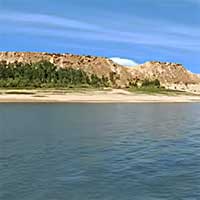 Glendo Reservoir is a 12,000-acre lake, with 40 miles of shoreline, is located in east-central Wyoming. As part of the North Platte River, it offers excellent fishing for big walleye and perch. It is also home to catfish, wiper, crappie, and white bass. There is access for fishing from the bank, and ice fishing in winter.
Glendo Reservoir is a 12,000-acre lake, with 40 miles of shoreline, is located in east-central Wyoming. As part of the North Platte River, it offers excellent fishing for big walleye and perch. It is also home to catfish, wiper, crappie, and white bass. There is access for fishing from the bank, and ice fishing in winter.
Primary fish species to catch
Click images for fishing tips and details about each species.
Today's Weather & Forecast
Fishing Boat Rentals
Click here for fishing boat rentals.
Public Boat Launch Ramps & Landings
Click here for boat ramps.
Marinas
Click here for marinas.
Fishing License
Click here for a Wyoming Fishing License.
Map - Fishing & Access
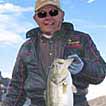 Rick Seaman is a fishing enthusiast with over five decades of fishing experience, a retired tournament fisherman, author of numerous published articles on fishing, and co-author of the book "Bass Fishing - It's not WHAT you throw, It's WHERE you throw it".
Rick Seaman is a fishing enthusiast with over five decades of fishing experience, a retired tournament fisherman, author of numerous published articles on fishing, and co-author of the book "Bass Fishing - It's not WHAT you throw, It's WHERE you throw it".
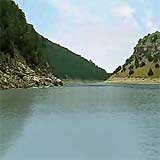 Contact Information
Contact Information
B & A Marina
383 Glendo State Park Rd
Glendo, WY 82213
307 274-2076
Fishing lakes in each state
102525
Glendo Reservoir, Wyoming Report
WYOMING


Information about fishing lakes in Wyoming
Glendo Reservoir offers walleye and perch, catfish and crappie fishing in east-central WY.






